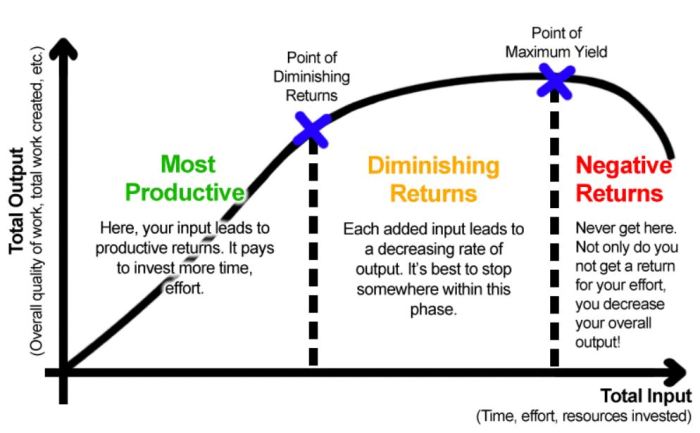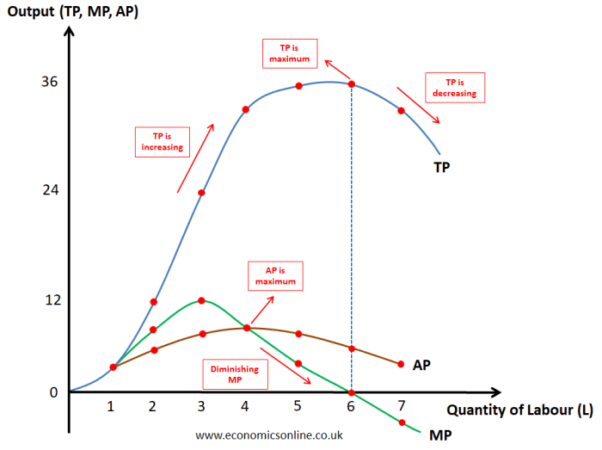
What is the law of diminishing marginal returns? It’s a fundamental economic principle that explains how the additional output gained from adding more of a variable input, like labor, to a fixed input, like land, eventually decreases. Think about a farmer planting more and more seeds in a fixed plot of land. Initially, the yield increases, but as the land becomes more crowded, the additional yield from each extra seed starts to decline. This law applies across various industries, impacting production costs, pricing strategies, and even long-term economic growth.
The law of diminishing marginal returns is a core concept in economics that helps us understand how businesses make decisions about resource allocation and production. It’s a powerful tool for analyzing how businesses can optimize their output and minimize costs.
Factors Influencing Diminishing Returns

The law of diminishing marginal returns is a fundamental principle in economics that explains the relationship between inputs and outputs in production. It states that as more units of a variable input are added to a fixed input, the marginal product of the variable input will eventually decline. This decline in marginal product is influenced by various factors, which we will explore in this section.
Fixed Inputs and Diminishing Returns
Fixed inputs, such as land, capital, and machinery, are resources that remain constant in the short run, regardless of the level of production. When fixed inputs are combined with increasing amounts of variable inputs, such as labor or raw materials, diminishing returns set in. This is because, at some point, the fixed inputs become a constraint, limiting the effectiveness of additional variable inputs. For example, if a farmer has a fixed amount of land, adding more workers to cultivate it will initially lead to increased output. However, as more workers are added, the land becomes increasingly crowded, and the marginal product of each additional worker will eventually decline.
Variable Inputs and Diminishing Returns
Variable inputs, on the other hand, are resources that can be adjusted in the short run. These inputs, such as labor, raw materials, and energy, are used in conjunction with fixed inputs to produce output. As more variable inputs are added, their marginal product initially increases, but eventually, it starts to decline. This decline can be attributed to several factors, including:
- Limited Capacity of Fixed Inputs: As more variable inputs are added, the fixed inputs become increasingly strained, leading to a decline in the marginal product of the variable inputs. For example, if a factory has a fixed number of machines, adding more workers will eventually lead to overcrowding and reduced efficiency.
- Increasing Specialization: In the initial stages of production, workers may be able to specialize in different tasks, leading to increased productivity. However, as more workers are added, the level of specialization may decrease, leading to a decline in marginal product.
- Inefficiencies: As more variable inputs are added, coordination and communication among workers may become more difficult, leading to inefficiencies and reduced output.
The law of diminishing marginal returns is a powerful tool for understanding the relationship between inputs and outputs in production. It highlights the importance of optimizing the use of both fixed and variable inputs to maximize efficiency and profitability.
Implications of Diminishing Returns
The law of diminishing marginal returns has significant implications for businesses and industries. It affects production costs, efficiency, pricing strategies, and market dynamics. Understanding these implications is crucial for making informed decisions and achieving long-term success.
Impact on Production Costs and Efficiency
Diminishing returns directly impact production costs and efficiency. As more units of a variable input are added while other inputs remain fixed, the marginal product of the variable input eventually declines. This means that each additional unit of the input contributes less to total output, leading to higher costs per unit of output.
For example, if a company increases the number of workers on an assembly line while keeping the size of the factory and equipment constant, the additional workers might initially increase production significantly. However, as the number of workers increases, the assembly line becomes crowded, and workers may start interfering with each other’s work. This leads to a decrease in the marginal product of labor, meaning that each additional worker contributes less to total output. As a result, the cost of producing each additional unit of output increases.
- Increased Labor Costs: Hiring more workers to compensate for diminishing returns can significantly increase labor costs.
- Reduced Efficiency: As marginal returns decline, the overall efficiency of production decreases, leading to higher costs per unit of output.
- Over-Utilization of Fixed Inputs: Diminishing returns can lead to over-utilization of fixed inputs, such as machinery or factory space, as businesses try to compensate for the declining marginal product of variable inputs. This can result in increased maintenance costs and reduced lifespan of fixed assets.
Impact on Pricing Strategies and Market Dynamics, What is the law of diminishing marginal returns
Diminishing returns also influence pricing strategies and market dynamics. As the cost of producing additional units of output increases due to diminishing returns, businesses must carefully consider their pricing strategies.
- Price Increases: To maintain profitability, businesses may need to increase prices as the cost of production rises due to diminishing returns.
- Market Competition: Diminishing returns can lead to increased competition in the market. As businesses face higher costs, they may be forced to lower prices to stay competitive, leading to a price war.
- Innovation and Differentiation: Businesses may need to innovate and differentiate their products or services to maintain profitability in the face of diminishing returns. This can involve introducing new features, improving quality, or finding new ways to reduce production costs.
Examples of Diminishing Returns in Practice

The law of diminishing marginal returns is not just a theoretical concept; it manifests itself in numerous real-world situations across various industries. This section explores practical examples of diminishing returns, highlighting specific scenarios where this principle has been observed.
Agriculture
The agricultural sector provides some of the most straightforward examples of diminishing returns. Consider a farmer who wants to maximize their yield from a plot of land. Initially, adding more fertilizer to the soil will result in a significant increase in crop production. However, as the farmer continues to add fertilizer, the increase in yield will gradually diminish. At some point, adding more fertilizer will have little to no effect on the yield, or even lead to a decrease due to potential soil damage. This is because the soil can only absorb and utilize a certain amount of nutrients. Adding more fertilizer beyond this point becomes ineffective and potentially harmful.
Closing Notes

Understanding the law of diminishing marginal returns is essential for businesses and policymakers alike. It provides a framework for making informed decisions about resource allocation, production processes, and pricing strategies. By recognizing the point at which diminishing returns set in, businesses can avoid overspending on resources and optimize their output. Ultimately, this law underscores the importance of efficiency and innovation in achieving sustainable economic growth.
Helpful Answers: What Is The Law Of Diminishing Marginal Returns
What are some real-world examples of diminishing marginal returns?
Think about a restaurant. Adding more servers initially improves service speed and customer satisfaction. However, if you keep adding servers, the kitchen might get backed up, and the additional servers might actually slow down service. Or, consider a factory that adds more machines. While more machines increase output initially, eventually, the factory space becomes too crowded, and the added machines might hinder production.
How does diminishing marginal returns affect pricing strategies?
As the cost of producing additional units increases due to diminishing returns, businesses must consider how to price their products. They may need to raise prices to maintain profitability or find ways to reduce costs to remain competitive.
Can diminishing returns be overcome?
While diminishing returns is a fundamental economic principle, it can be mitigated through innovation, technological advancements, and resource allocation. For example, a company might invest in new technology to increase efficiency or find ways to utilize resources more effectively.





